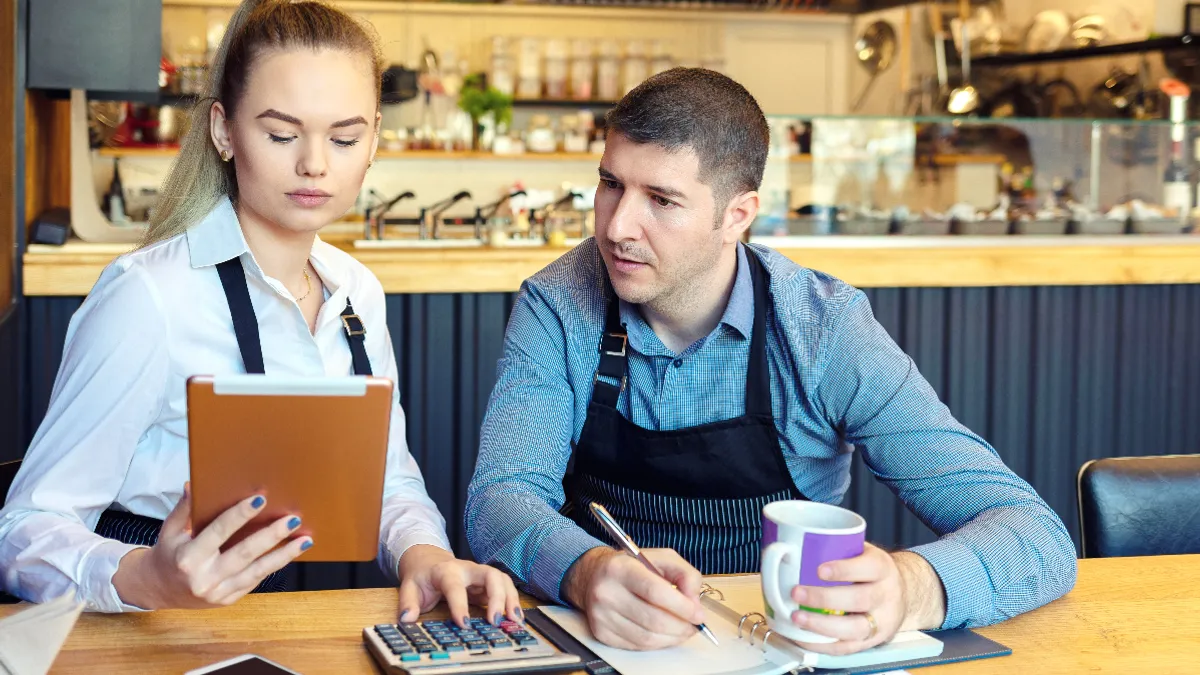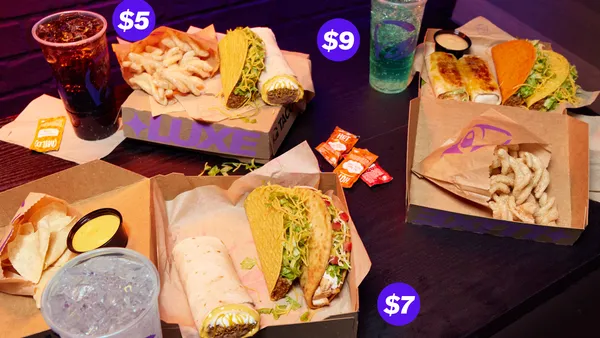From the rise of mobile delivery apps to the challenges of labor inflation, the restaurant industry weathered dynamic market changes in 2018 — driving the rise of "ghost restaurants," delivery and catering formats and eye-catching benefits packages. But what are the trends to watch for this year?
According to analysts interviewed by Restaurant Dive, the impact of these movements — along with evolving consumer expectations for menu solutions, dining experience and convenience — will intensify in 2019. To overcome these obstacles and stand out from competitors, experts predict that restaurants will double down on digital offerings and continue to experiment with new brick-and-mortar configurations for quick-service formats.
"For the restaurant sector as a whole, we don't expect much growth in [2019]," David Portalatin, vice president and food industry analyst at the NPD Group, told Restaurant Dive. "But you will see individuals succeed because they're taking part in digital strategies, [new] meal solutions...and experience differentiation."
Here are the six trends expected to spark major restaurant storylines in 2019.
-
Delivery disruption
Though only 2.8 million (or about 5%) of the 61 million restaurant orders made annually occur online today, according to NPD Group research, this channel's potential has spurred investments from restaurants across categories. And while this digital push is shaping everything from point-of-sale systems — such as McDonald's and Wendy’s rollout of self-service kiosks — to reservation processes, delivery is arguably experiencing the most powerful transformation.
"One of the fundamental truths of how we eat in America today is that we increasingly want to consume our food at home — 50% of dinner meals purchased from a restaurant are actually consumed at home," Portalatin said.
A host of mobile food delivery apps such as DoorDash, Postmates and Uber Eats have cropped up to meet this consumer demand for fast, frictionless meal solutions. These apps are also meeting diners where they're already at — according to a report from BRP Consulting and Windstream Enterprises, mobile devices facilitated or supplemented 38% of dining experiences, whether that be through pre-ordering, checking reviews or sharing pictures online of their meal.
These changing diner demands and accompanying technologies bring significant growth opportunities to restaurant operators, with digital sales estimated to spike from 6% of overall sales in 2017 to 30% by 2025, per the report. This change is also impacting brick-and-mortar formats.
"We're already starting to see virtual kitchens pop up that are delivery only … where you can place your banner purely in the domain of a Grubhub or Uber Eats or DoorDash … and there is no front of the house. And so the cost implications of operating that model when you don't have to worry about prime real estate or expensive overhead ... and all those kinds of things really have the potential to transform the restaurant industry,” Portalatin said.
But these "ghost restaurant" formats — a concept Chick-fil-A is testingto meet consumer demand for convenience and preserve its quality of service at traditional formats — make up only a very small percentage of the marketplace, William Blair analyst Sharon Zackfia said. They also pose some significant challenges for new entrants.
"The reason why I think it's going to be difficult to have a pure digital restaurant experience is that there's no brand awareness. If you go into DoorDash and you're scrolling through 300 restaurants, why do you order from [my restaurant] if you don't know who I am and you've never been in one of my locations?" Zackfia said. "I still think a brick-and-mortar presence and that experiential dynamic will be important. We're seeing that still in retail even after 30 years of the internet."
Still, experts feel that expanding digital touch points and honing online strategies are no longer a bonus for restaurants, but a necessity.
"Restaurants who are leaders in engaging their customers digitally ... using digital apps or third-party services to facilitate delivery orders ... have an opportunity to grow in the coming year," Portalatin said.
-
Surge in fast casual dining
Though analysts forecast flat growth for the restaurant space in 2019 — a trend Portalatin attributes to reduced spending by "peak" restaurant-going demographic of diners in their mid-twenties to thirties — experts have also observed an uptick in fast casual dining.
"We're continuing to see fast casual chains take a growing share of the total restaurant landscape… [they offer] enhanced quality, but still a valuable price point,” Portalatin said. "We live in a culture now where we're all foodies… elevated cuisine is no longer relegated to the realm of fine dining."
Fast casual's growth has slowed over the course of this year, but still holds growth potential for the industry, according to a Technomic Report. Total fast casual sales growth in 2017 was 9% for the top 250 restaurant chains, according to the publication. Growth in the segment by unit fell for the third year in a row last year, slipping to 6.1% to 9.8% in 2015, but fast casual chains such as CoreLife Eatery and Wahlburgers reported triple-digit growth for the year.
"America, it appears, is no longer a fast food nation. It's a fast casual nation," food reporter Tim Carman wrote in the Washington Post.
Zackfia said it's difficult to pinpoint what's driving this trend, but noted that restaurants in general have been becoming more casual over the past decade."There aren't too many restaurants where you have to dress for dinner. Even at the best restaurants you can usually walk in with jeans," she said.
Time-strapped diners also appreciate the efficiency of fast casual restaurants, which offer counter service that give patrons more control over their experience from start to finish.
"One of the biggest gripes about fine or casual dining is how long the entire meal takes from start to finish," NPD Group analyst Warren Solocheck told SmartBrief. "I would characterize us in the U.S. as being more ADD than ever before. Few of us on few occasions actually have the time to sit through a white tablecloth sort of occasion. If these fine casual restaurants can get you over the hump on speed, I think it goes a long way."
Ambiance and dress code aside, casual dining formats have also caught fire because the format relieves restaurant owners of the labor costs and staffing sizes traditionally associated with nicer restaurants.
-
Labor issues
In 2017, 37% of National Restaurant Association members said that labor recruitment was their biggest obstacle — marking a 15% rise from two years ago. With labor inflation, crackdowns on undocumented workers and a steady stream of new restaurants expected to persist for the foreseeable future, the challenge of finding and retaining talent will continue to plague operators across categories this year, analysts said.
"It's part of the reason that the cost of a restaurant meal continues to rise disproportionately to say the cost of going grocery shopping. And so that creates a headwind for restaurant consumption," Portalatin said.
Razor-thin margins also make it difficult to raise wages to differentiate from competitors in this environment, though a growing number of employees are demanding a living wage. Last year, for example, disgruntled restaurant workers across nearly 50 cities participated in Fight for $15 walk-outs and protests to demand a $15 minimum wage and the right to join a union.
This year, 19 states have rolled out higher minimum wages. New wages range from $8.04 in Minnesota for some employees to $15 for fast food workers in New York City. Washington, D.C. and Oregon also have wage hikes set to take effect in July. But these wage changes are putting pressure on restaurant operators, who are also contending with rising rents. In the Bay area, which adopted a $15 minimum wage in last summer, some independent operators have responded by transitioning from full service to counter service to keep costs low.
Zackfia said that this strategy is unlikely to make its way upstream at national chains, but that restaurants do need to be willing to make changes in order to attract desirable workers.
"When it's hard to find labor, you have to find ways to be more creative, whether it's with the wage or with the benefits or with other elements that make you more attractive to an employee than the restaurant down the road," she said. "As digital [innovation] continues to ramp up, you can redeploy labor away from things like cash registers toward more value-added activities ... to improve guest satisfaction."Restaurant chains are also beefing up their benefits to hold on to workers. Noodles & Company, for example, announced in September that it will allow expectant and new mothers the opportunity to work an 80% schedule the four weeks prior and four weeks after maternity leave at full pay. One month later, Starbucks rolled out subsidized backup child and adult care for full- and part-time employees.
-
New definitions of value
As consumer values shift to place a higher premium on convenient, affordable and flexible eating occasions, restaurants are evolving their menus to accommodate.
"You're going to see some large quick-service restaurant chains continue to do well even in a difficult marketplace because they're really dialed in on value," Portalatin said. "They will continue to hone their menu offerings. They will enhance those with limited-time offers and they will ... have their finger on the pulse of the value-oriented consumer."
More than a third (37%) of diners are looking for value-priced deals more than 2016, according to Technomic's 2017 Value & Pricing report. Millennials in particular are hungry for deals, with 46% of this dining demographic looking for deals more often. Taco Bell's recently revamped value menu is likely a lure for this demographic, as the company hopes to become the the generation's favorite brand.
Portalatin also said that independent operators and micro-chains will lead the way in pinpointing what it is consumers want out of their restaurant meals in 2019.
"You will continue to see some growth in that sector of the industry because that's where you're often seeing sort of the creative class of chef-inspired cuisines that are offering something a little bit more on that experiential end of the spectrum. ... Anytime you can take something that the consumer already enjoys and you can elevate it slightly or enhance the experience in some way, then that's a win with the consumer," he said.
According to NPD Group, one of the biggest menu demands that have been shaping the marketplace of late is interest in blended, eat-at-home meals. In 2017, for example, 18% of at-home meals included at least one ready-to-eat food product from the foodservice channel, an uptick of 15.5% in 2015. Restaurants can cash in on this trend by offering packaged prepared foods meant for takeaway alongside their made-to-order menu items, a strategy chains such as Starbucks have doubled down on in recent years.
"Restaurants [need to] take a look at the menu and adopt more of a meal solutions approach because the reality of eating at home for a lot of consumers... sometimes it means we prepare a completely homemade meal. Sometimes it means we source an entire meal from a restaurant. But increasingly it means that we blend the two together," Portalatin said.
Chick-fil-A has pushed this concept the farthest. In July, it began testing branded meal kits at 150 Atlanta locations, making it the first fast-food chain to enter the meal kit market. Michael Patrick, the company's Mealtime Kit program lead, told NPR that the new menu offering allows Chick-fil-A to "solve two meal problems in one visit," giving it a leg up on both competing restaurants and pure play meal kit makers like Blue Apron.
If the chicken restaurant's meal kit trial is successful, it could signal further opportunities this year for restaurants to innovate in prepared food offerings meant to be eaten or cooked at home.
-
Plant-based menu items
Growing consumer distaste for red meat, fear of antibiotics and interest in personal and environmental health have made plant-based foods a hot opportunity for restaurants across segments. In 2017 alone, U.S. consumers shelled out nearly $700 million on meat substitutes — a 25% jump from 2012 — and Nielsen reports that annual plant-based food sales now exceed $3.5 billion.
Portalatin said that providing trendy alternative proteins can be a powerful differentiator in today's restaurant market.
"For the majority of people that are eating alternative proteins, it's about health, but for some percentage of them it's a play on reducing the footprint of animal production. In the restaurant landscape we are seeing triple digit rates of growth of restaurant operators who are buying meat alternatives to put on the menu. So that's another trend that will continue to accelerate throughout the year," he said.
White Castle has found big success in introducing plant-based protein alternatives, launching its meat-free Impossible Burger slider at all 377 restaurant locations nationwide in September following a test at select locations in April. The fast food chain is the first mainstream restaurant to offer a meat analogue like the Impossible Burger — which "bleeds" and sizzles on the grill like real beef — spurring more than 63,000 fans to sign an online petition asking McDonald's to adopt similar menu items. And just last week, Carl's Jr. launched a plant-based version of its signature Famous Star burger — swapping in a Beyond Meat patty for beef — at 1,100 restaurant locations through the month of January.
This trend is also reflected in the growth of specialty vegan restaurant chains. Fast casual chain VeganBurg, for example, announced in October that it plans to open 300 franchised locations — just three years after opening its first U.S. store in San Francisco. The chain, which began in Singapore and offers a 100% plant-based menu, also has plans to grow its footprint in Indonesia and Southeast Asia.
Instagram darling and NYC-based vegan restaurant By Chloe is also gaining ground, securing $31 million in funding led by Bain Capital earlier this year and raking in $1 million in annual revenue, according to Crunchbase data.
-
Investing in experience
As diners have increasingly associated eating out with an opportunity to post on social media, restaurants have raced to remodel stores to boost their "experience" factor. Increasingly, front-of-house design is made with Instagram in mind, and consumers expect more from their restaurant of choice than just a good meal.
But this hunger for a premium experience extends beyond just post-worthy ambiance.
"Differentiating on experience can be a lot of different things. In some respects it's that Instagrammable or Snapchatable moment ... but in some cases it can just be simply better service, better quality of execution in the restaurant," Portalatin said.
To enhance customer experience in meaningful ways, it's important for restaurant operators to have an accurate picture of who their diners are, what they want and how their brand's ethos stands out from competitors.
Buffalo Wild Wings, for example, recently unveiled a high-end new restaurant design that returns to the chain's sports bar roots. The revamped format boasts eye-catching design, including bars made from recycled basketball courts, a dual waiting area and lounge called the Dugout — with sports bleachers for guests to sit and watch tv from — and LED lights that change based on the crowd's noise levels.
Starbucks also opened a 23,000-square-foot roastery — complete with a cocktail bar and local art — last month, and the coffee titan plans to launch the concept in Chicago and Tokyo this year.
But restaurants should be cautious of too much change at once, especially when it comes to store formats. Since launching McDonald's "Experience of the Future" redesign in 2015, the fast food giant has extended its remodel deadline for franchisees because sales aren't yet making up for operator investments.
"When you have a market that's very mature and not really organically growing, then any incremental way you can differentiate yourself is beneficial," Portalatin said.











